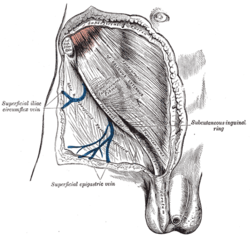Fascia of Scarpa
| Fascia of Scarpa | |
|---|---|
 The subcutaneous inguinal ring. (Superficial fascia visible at top.) | |
| Details | |
| Identifiers | |
| Latin | stratum membranosum telae subcutaneae abdominis |
| TA98 | A04.5.02.022 |
| TA2 | 7093 |
| FMA | 72080 |
| Anatomical terminology | |
The deep layer (fascia of Scarpa) is a layer of the anterior abdominal wall. It is found inferior to the Camper Fascia and superior to the External Oblique muscle.
Anatomy
It is thinner and more membranous in character than the superficial fascia of Camper, and contains a considerable quantity of orange elastic fibers.
It is loosely connected by areolar tissue to the aponeurosis of the Obliquus externus abdominis, but in the middle line it is more intimately adherent to the linea alba and to the symphysis pubis, and is prolonged on to the dorsum of the penis, forming the fundiform ligament; above, it is continuous with the superficial fascia over the rest of the trunk; below and laterally, it blends with the fascia lata of the thigh a little below the inguinal ligament; medially and below, it is continued over the penis and spermatic cord to the scrotum, where it helps to form the dartos.
From the scrotum it may be traced backward into continuity with the deep layer of the superficial fascia of the perineum (superficial perineal fascia or Fascia of Colles).
In the female, it is continued into the labia majora and from there to the Fascia of Colles.
Eponym
It is named for Antonio Scarpa[1][2]
References
- ^ synd/2925 at Who Named It?
- ^ A. Scarpa. Sull' ernie: memorie anatomico-chirurgiche. Milano, d. reale Stamperia, 1809; 2nd edition, 1820.
External links
- Template:MUNAnatomy
- Anatomy photo:35:03-0103 at the SUNY Downstate Medical Center
- Anatomy figure: 35:03-03 at Human Anatomy Online, SUNY Downstate Medical Center
- Atlas image: abdo_wall57 at the University of Michigan Health System
- Anatomy image:7410 at the SUNY Downstate Medical Center
- Anatomy image:7042 at the SUNY Downstate Medical Center
![]() This article incorporates text in the public domain from page 408 of the 20th edition of Gray's Anatomy (1918)
This article incorporates text in the public domain from page 408 of the 20th edition of Gray's Anatomy (1918)
